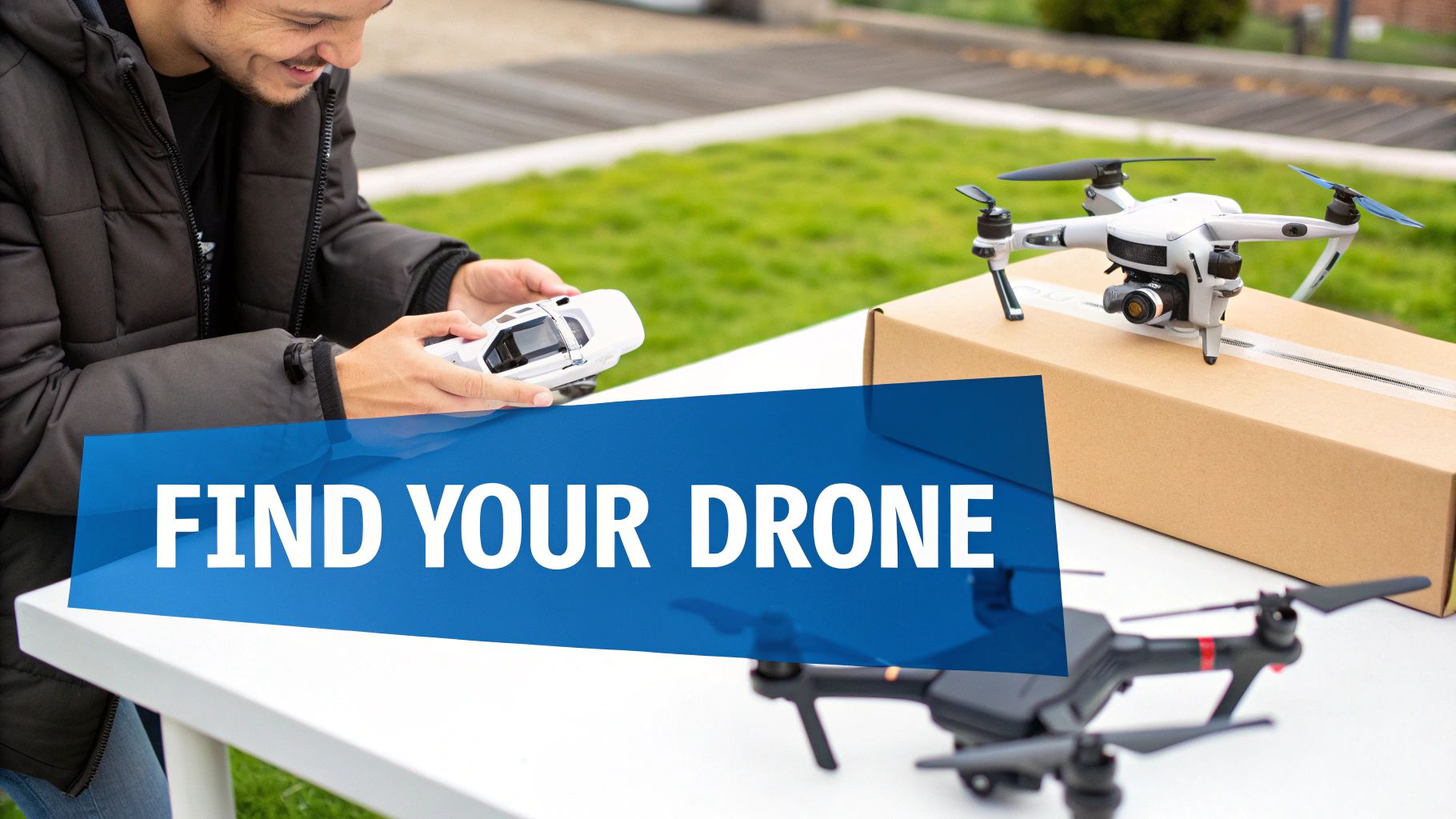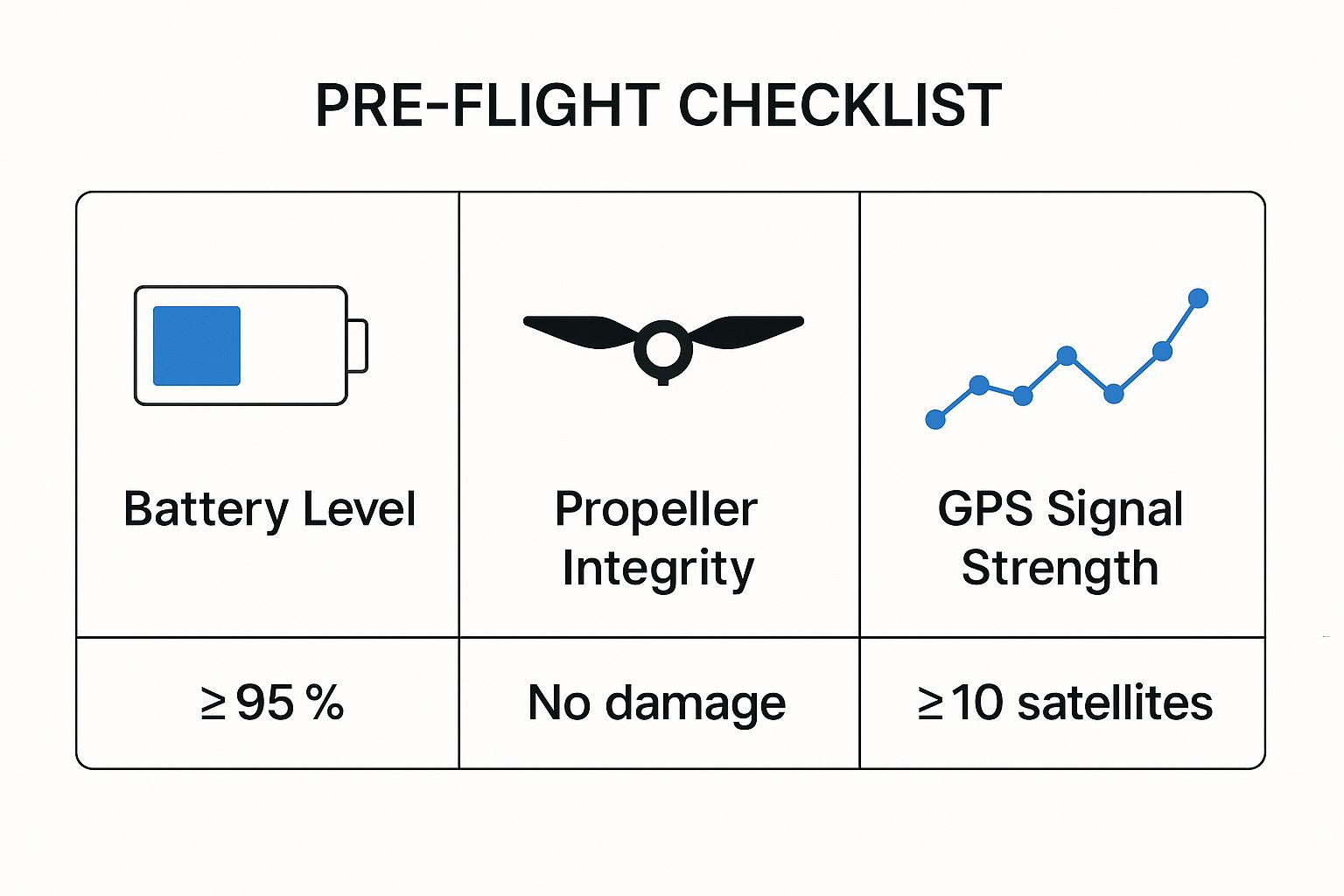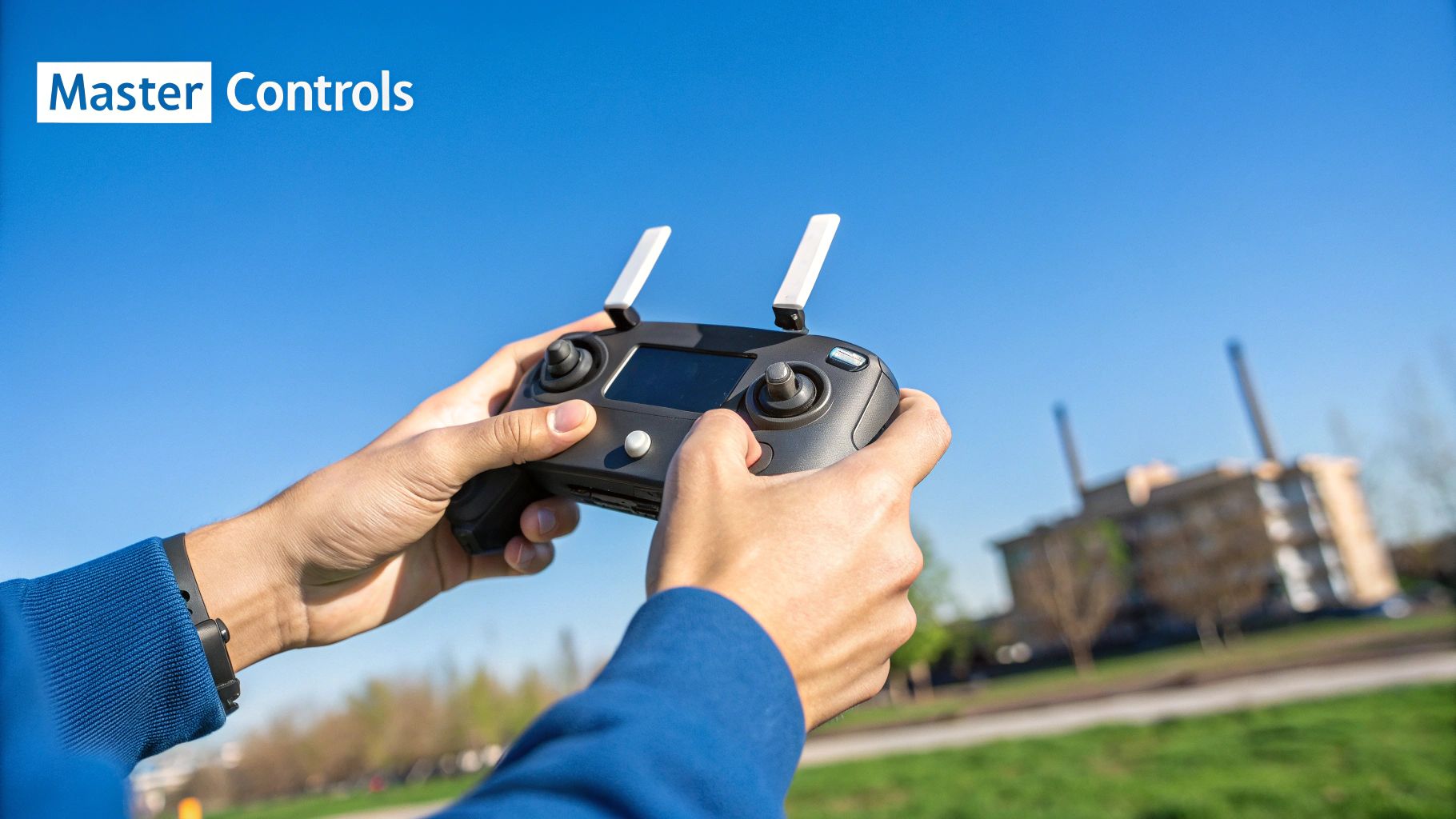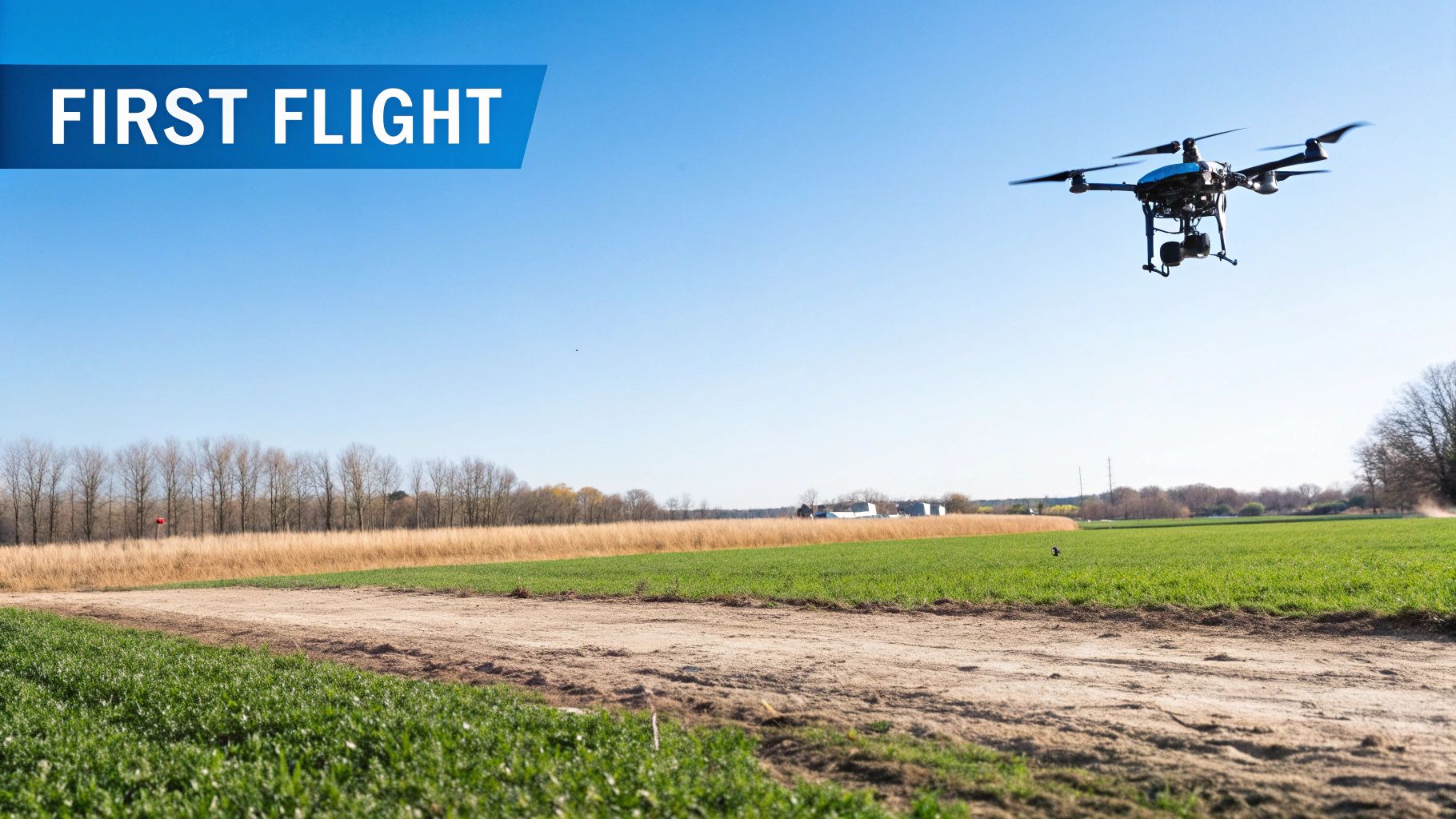How to Fly a Drone for Beginners: Easy Flight Tips
- Paul Simmons

- May 11
- 13 min read
The Beginner's Launch Pad: Essential Drone Fundamentals
Stepping into the world of drones can feel overwhelming at first. However, understanding the basics can make all the difference. For new pilots, learning about the core components – the transmitter, motors, and flight controller – is essential for safe and enjoyable flights.
Understanding Your Drone's Anatomy
Just like a car, understanding how your drone works is key. The transmitter is your main control, allowing you to adjust altitude, direction, and other functions. Its joysticks translate your movements into flight commands. The motors, usually four on a quadcopter, provide the power for lift and movement. And finally, the flight controller, located inside the drone's body, is vital for stability and maneuverability. It takes input from the transmitter and adjusts the motor speeds accordingly.
Choosing the Right Drone for Beginners
Selecting your first drone is an important step. Different drone classes cater to various skill levels and budgets. While advanced drones might seem appealing, starting with a smaller, more affordable trainer drone is often more beneficial. These trainer drones are designed for durability and ease of control, allowing new pilots to practice without the risk of damaging a costly investment.
Beyond the Hype: Focusing on What Matters
It's easy to get lost in the technical jargon used by manufacturers. However, many advertised specifications are less important for beginners. Focus on essential features like flight time, camera quality (if you plan on taking photos or videos), and ease of use. You might be interested in: How to master.... Looking to improve your videos? Consider professional drone video services.
The Growing Drone Market
The drone market is expanding rapidly, projected to reach $57.8 billion by 2030. Find more detailed statistics here. This growth means more resources and communities available to help new pilots learn and improve their skills. With solid foundational knowledge and informed decisions, your drone flying journey can be successful and enjoyable.
Flight Preparation: Setting Yourself Up For Success

Confident drone pilots know that successful flights start well before takeoff. A consistent pre-flight routine is key, especially for those just starting out. This disciplined approach helps minimize potential issues and maximize your enjoyment in the air.
Essential Equipment Checks
Just like a pilot inspects an aircraft, you need to check your drone. This involves a thorough examination of the propellers for any damage, ensuring a fully charged battery, and confirming the camera and gimbal are working properly.
A simple pre-flight check can prevent costly repairs and ensure a safe flight.
Before each flight, take a few minutes to carefully inspect your equipment. This includes checking for loose propellers, which could cause instability mid-flight, and verifying your battery level to avoid a sudden, unexpected descent.
Here's a handy table summarizing essential pre-flight checks:
Essential Pre-Flight Checklist Items: A comprehensive list of checks to perform before flying your drone
Checklist Item | Purpose | How to Check |
|---|---|---|
Propellers | Ensure safe and stable flight | Visually inspect for cracks, chips, or loose connections |
Battery | Provide sufficient power for the flight | Check the battery level indicator on the drone or remote controller |
Camera and Gimbal | Capture clear and stable footage | Power on the drone and check the camera feed for any issues, ensure the gimbal moves freely |
Firmware | Ensure the drone's software is up-to-date | Check the manufacturer's website or app for the latest firmware version |
Sensors | Ensure obstacle avoidance and stable flight | Check that the sensors are clean and free of obstructions |
This checklist helps ensure a smooth and safe flight, allowing you to focus on enjoying the experience. Regularly inspecting your equipment can also extend its lifespan.
Understanding Weather Conditions
Weather plays a critical role in drone flight. Even a slight breeze can greatly affect stability, particularly for lighter drones.
New pilots should familiarize themselves with weather forecasts, paying close attention to wind speed, direction, and gusts.
Also, be aware of any weather-related no-fly zones, such as areas with thunderstorms. Being weather-aware helps prevent damage to your drone and ensures safe flying practices.
Selecting Your Flight Location
Choosing the right location is just as important as the pre-flight checks. Beginners should opt for wide-open areas, free of obstacles such as trees, power lines, and buildings.
Be aware of local regulations and respect privacy. Flying near airports or private property is often restricted. Check for any local ordinances or permit requirements before you fly.
Careful planning allows you to focus on your flying skills, not potential hazards. Responsible flying practices are crucial, especially with the growing demand for skilled drone operators. The commercial drone market is experiencing substantial growth. Between 2021 and 2025, it saw a compound annual growth rate (CAGR) of 14.42%, representing an increase of $21.01 billion. Explore this topic further.
Mastering these pre-flight steps helps you confidently transition to learning the controls. This preparation not only ensures a safe and successful flight, but also sets the foundation for becoming a proficient drone pilot.
Mastering Your Controls: The Foundation of Flight
Behind every breathtaking drone shot is a pilot with finely tuned control reflexes. For beginners, learning how to fly a drone begins with understanding the relationship between the transmitter sticks and the drone's movements. This section will break down seemingly complex maneuvers into simple exercises that will help you build muscle memory and confidence in the air.
Understanding the Control Sticks
Think of your transmitter like a video game controller, but for the sky. The right stick is primarily responsible for the drone's orientation and movement. Moving the right stick right or left initiates a yaw, rotating the drone clockwise or counterclockwise on its vertical axis. Pushing it forward or backward commands a pitch, tilting the drone forward or backward to initiate forward or backward movement.
The left stick, on the other hand, controls altitude and strafe. Moving the left stick up increases the drone’s altitude, while moving it down brings it closer to the ground. Moving it left or right performs a strafe, allowing the drone to move laterally left or right without changing its orientation.
Before your first flight, it's essential to perform a comprehensive pre-flight check. For guidance, consult this helpful resource: drone pre flight checklist.
The Importance of Hovering
Mastering the hover is absolutely fundamental to drone flight. It's like learning to balance on a bicycle before you start pedaling. Professional drone pilots often emphasize this skill as the cornerstone of all other maneuvers.
Practice hovering in a safe, open area, free from obstacles, until you can effortlessly maintain a stable position. This builds both your confidence and your sensitivity to the controls. For further tips, consider this resource: How to master...
Incremental Practice Drills
Start with short flights concentrating on basic movements. Focus on smooth, gentle ascents and descents, along with gradual turns. As you become more comfortable, gradually increase the complexity of your flight patterns.
Incorporate strafes and then combine movements, such as yawing while pitching forward. This incremental approach helps you progressively build your skills without feeling overwhelmed. Once your basic control improves, consider setting up a simple obstacle course using cones or other markers. This translates your basic control skills into more practical, real-world flight scenarios.
To help visualize important pre-flight checks, take a look at the infographic below:

Ensuring these three pre-flight checks – Battery Level (≥95%), Propeller Integrity (No damage), and GPS Signal Strength (≥10 satellites) – are in optimal condition significantly increases the chance of a successful and, most importantly, safe flight. Overlooking these checks can lead to critical flight failures and potentially dangerous crashes.
The demand for drone services has led to a remarkable surge in drone flights globally. In 2024, global drone flights increased by 25%, totaling 19.5 million flights. Asia led the way with the highest number of flights, reaching 6.3 million. This growth reflects the increasing demand for skilled drone operators. Learn more about drone market growth here.
Developing Control Sensitivity
With consistent practice, you’ll start to develop a “feel” for your drone’s responsiveness. This control sensitivity involves understanding how even the slightest stick movements translate into changes in the drone’s position and orientation.
This refined control allows you to make precise adjustments, maintain stability even in challenging conditions, and execute smoother, more controlled flights. The ability to react quickly and accurately to unexpected gusts of wind or other unforeseen situations is a crucial skill for any aspiring drone pilot. Remember, consistent practice is the key to unlocking your full potential as a drone pilot.
To further illustrate the functions of the drone controls, let's look at a comparison table. This table details the control stick functions, provides beginner tips, and highlights common mistakes to avoid.
Drone Control Functions Comparison
Control | Function | Beginner Tips | Common Mistakes |
|---|---|---|---|
Right Stick (Up/Down) | Pitch (Forward/Backward) | Start with small, gentle movements. Practice maintaining a constant speed. | Pushing the stick too far forward can lead to rapid altitude loss. |
Right Stick (Left/Right) | Yaw (Rotate Left/Right) | Use yaw to adjust your drone's heading while hovering. Practice smooth, controlled rotations. | Over-correcting yaw can lead to disorientation. |
Left Stick (Up/Down) | Throttle (Ascend/Descend) | Make small adjustments to altitude. Avoid rapid ascents or descents. | Rapid descents can lead to hard landings. |
Left Stick (Left/Right) | Strafe (Lateral Movement) | Practice strafing left and right while maintaining altitude. | Combining strafe with other movements can be challenging initially, so practice in a safe open area. |
This table provides a quick reference for understanding the basic control functions of your drone. By studying this table and practicing the suggested tips, you can avoid common mistakes and build a strong foundation for drone flight.
Navigating The Rules: Safety Protocols That Matter

Flying a drone is undeniably exciting, but responsible operation is paramount. It's not just about following the rules; it's about creating a safe environment for everyone who enjoys drones. This means understanding which rules are absolute and which offer some flexibility.
Understanding The Regulations
Regulations can seem overwhelming initially, but they're designed with safety as the top priority. One key aspect is line of sight rules. These usually require keeping your drone within your visual range. You should also be aware of altitude restrictions, often limited to 400 feet. Understanding the specifics of these regulations is equally important.
Risk Assessment For Beginners: A Practical Approach
Knowing the rules is essential, but so is assessing risks before each flight. Professional drone operators consistently analyze potential hazards and develop mitigation strategies. Beginners should adopt this practice. Ask yourself: Are there obstacles like power lines? What are the wind conditions like? Are there people nearby? These quick checks will change how you approach each flight, prioritizing safety.
Non-Negotiable Rules Vs. Flexible Interpretation
Some rules are absolute, like avoiding restricted airspace near airports. Others allow for situational assessment. For example, while maintaining visual contact is key, using a spotter can extend your range while still adhering to the spirit of the regulations. Understanding the "why" behind the rules helps you apply them safely and effectively. You might be interested in: How to master...
Learning From Experience: Real-World Case Studies
Real-world examples best illustrate the reasons behind regulations. Consider a pilot who loses control because they ignored high wind warnings, resulting in a near-miss with a building. This highlights the importance of respecting weather conditions. Conversely, a pilot successfully navigating a complex area by carefully planning demonstrates the positive impact of pre-flight preparation. Learning from both successes and failures within the drone community is crucial.
Developing A Safety Mindset
Responsible drone operation cultivates a safety mindset. It balances the excitement of flying with the responsibility of sharing airspace. This lets beginners enjoy their drones while respecting the broader aviation community and those on the ground. This conscientious approach ensures drones remain a source of enjoyment and innovation.
Take-Off and Landing: The Critical Flight Moments
The first and last moments of any flight – the takeoff and landing – are undeniably the most crucial. These are the times when your drone is at its most vulnerable. This section will break down the techniques professionals use for consistently smooth takeoffs and pinpoint landings, regardless of the conditions.
Mastering the Takeoff
A smooth takeoff sets the tone for a successful flight. Before you even think about lifting off, make sure your drone is on a level surface. This simple step prevents tipping during liftoff. Then, slowly increase the throttle using the left stick. Think of it like gently accelerating in a car.
As your drone ascends, keep a close eye on its stability. Minor adjustments with the right stick can correct any drift. Aim for a steady, controlled climb to a safe initial altitude, generally around 10-20 feet. This allows you to get a feel for the controls and orient yourself before attempting more complex maneuvers.
Also, be aware of ground effect. This phenomenon, created by the interaction of your drone’s propellers with the ground, can cause turbulence during takeoff and landing. You can compensate for this by using slightly more throttle than usual during the initial ascent and final descent.
The Art of Landing
Landing safely is just as important as taking off smoothly. Begin your descent by gradually decreasing the throttle, maintaining control with small stick movements. As you get closer to the ground, slow your descent even further. Imagine you're trying to land a feather – soft and controlled.
The moment your drone touches down, immediately cut the throttle to zero. This prevents the propellers from spinning unnecessarily, much like putting a car in park after stopping to prevent unwanted movement. This simple action protects the motors and ensures a secure landing.
Handling Emergency Scenarios
Even during takeoff or landing, unexpected issues can arise. This is why practicing emergency procedures is so important. A common scenario is a low-battery warning. If this happens during flight, immediately begin a controlled descent. Look for a safe landing spot, prioritizing open areas without obstacles.
But what if an unforeseen obstacle suddenly appears? Your best bet is to quickly assess the situation and take decisive action. This might involve a rapid ascent, a sideways movement, or even a quick rotation to reorient the drone. Practice builds confidence for these critical moments.
Practice Makes Perfect
The key to confident takeoffs and landings is practice. Find a suitable practice area and rehearse these maneuvers repeatedly. As you become more experienced, introduce more challenging scenarios, such as landing on uneven terrain or dealing with light winds. In 2024, global drone flights reached 19.5 million, highlighting the growing popularity of this activity. Learn more about drone market growth Don't just memorize the steps; understand the reason behind each action. This develops your intuition, allowing you to react quickly and efficiently in any situation. Mastering these fundamental techniques turns potentially stressful flight moments into routine procedures.
Overcoming Common Obstacles: Troubleshooting Like a Pro

Even with meticulous planning, new drone pilots are likely to encounter some challenges during their first flights. Learning to fly effectively goes beyond simply mastering the controls. It also involves understanding how to diagnose and resolve common issues. This proactive approach turns potential frustrations into valuable learning opportunities.
Decoding Your Drone's Language
Think of your drone communicating through its behavior. Unusual flight patterns, odd sounds, and warning lights on the controller all offer clues about underlying problems. A high-pitched whine from the motors, for instance, might point to a propeller or motor issue. A persistent drift in one direction could indicate a problem with the gyroscope or accelerometer.
By carefully observing your drone, you can often identify issues before they become major problems. Read also: How to Master...
Common Calibration Routines
Many drone problems can be fixed with simple calibration routines. Most drones have built-in calibration procedures for the compass, gyroscope, and other sensors. These calibrations are typically accessed through the drone's app or software interface.
Regularly calibrating these components ensures your drone flies as expected, preventing potential mid-flight problems. This is especially important in areas with magnetic interference, which can affect the compass and cause erratic flight.
Troubleshooting Trees: A Systematic Approach
A systematic approach is key when facing a problem. Imagine your drone is hovering unsteadily. Several factors could cause this, from low battery power to wind gusts to sensor malfunctions.
Start by ruling out the obvious, such as a low battery or strong winds. If the problem continues, move on to more technical checks, like recalibrating the IMU (Inertial Measurement Unit). A troubleshooting tree, a method branching from general to specific possibilities, helps diagnose issues logically and efficiently.
Real-World Scenarios and Solutions
Consider this: your drone suddenly tilts and descends uncontrollably. This might panic a new pilot. However, by applying troubleshooting knowledge, you might recognize this as a possible damaged propeller.
Upon inspection, you find a cracked propeller. Replacing it allows you to safely resume your flight. These practical experiences become invaluable lessons, significantly contributing to your growth as a drone pilot.
The Psychology of Troubleshooting
Troubleshooting isn't just technical; it's also about decision-making under pressure. Knowing when to abort a flight is as crucial as knowing how to fix a problem. If troubleshooting fails, or the drone becomes increasingly erratic, landing immediately is often best.
By developing diagnostic skills and a calm, systematic approach, you'll not only avoid potential crashes but also gain confidence in handling any challenges during your drone flights. This helps you become a more capable and self-sufficient pilot.
Elevating Your Skills: The Path to Drone Mastery
So, you've nailed the drone basics – takeoffs, landings, and those essential first maneuvers. Now, it's time to level up your skills and truly unlock your drone's potential. Whether you're drawn to breathtaking aerial photography, captivating videography, the adrenaline rush of drone racing, or even the possibilities of commercial drone operations, this guide will chart your course to drone mastery.
Refining Your Control: Precision and Artistry
Basic maneuvers are just the starting point. True drone mastery lies in precision and refined control. Practice smooth, deliberate flight patterns, like figure eights and square grids. This refines your control sensitivity, allowing for finer adjustments and increasingly complex maneuvers.
Imagine navigating your drone through a series of elevated hoops. This exercise demands precise throttle control, coordinated yaw and pitch movements, and a keen awareness of your drone's position in 3D space. This level of control opens up a world of creative flight paths, blending technical skill with artistic expression.
The Art of Aerial Composition: Perspective and Storytelling
Consider how photographers compose captivating shots on the ground. Now, imagine achieving that same level of artistry from the air. The aerial perspective offers unique opportunities for framing your shots and telling stories from an entirely new vantage point.
Even slight adjustments in your drone's position can dramatically impact your results. Lowering your drone just a few feet might reveal hidden details in the landscape, while increasing the altitude can provide a broader, more contextual view. A subtle shift in angle could align your subject with leading lines, adding depth and visual interest to your image.
Structured Practice: The Key to Skill Development
While casual flying can be enjoyable, structured practice is essential for skill development. Professional drone pilots dedicate time to focused skill-building exercises.
This might involve repeated takeoffs and landings to achieve consistently smooth touchdowns or practicing complex maneuvers to improve reaction time in challenging conditions. Identifying areas for improvement and tailoring your practice routines is a hallmark of skilled drone pilots.
Specialized Flight Modes: Expanding Your Capabilities
Many modern drones boast specialized flight modes that can automate certain tasks. Modes like Follow Me or ActiveTrack can significantly enhance your capabilities. Follow Me instructs the drone to autonomously follow your movements, perfect for capturing action shots without a second operator. ActiveTrack allows you to select a subject, and the drone will intelligently keep it centered in the frame, ideal for filming moving subjects.
Finding Your Niche in the Drone Community
The drone community is a vibrant and diverse network, encompassing everyone from hobbyist photographers to professional racers. Connecting with other pilots offers invaluable learning opportunities. Consider joining online forums, attending local meetups, or participating in drone-related events.
Whether your passion lies in photography, videography, racing, or commercial applications, identifying your interests helps you focus your skill development and connect with like-minded individuals within the community. This support system can be incredibly beneficial for continued learning, sharing experiences, and staying informed about the latest industry developments.
Ready to take your drone journey to new heights? Check out JAB Drone, your ultimate resource for all things drone-related. From expert reviews and insightful articles to community forums and the latest industry news, JAB Drone empowers you with the knowledge and resources to explore the world of drones safely and creatively. Join the Sky Squad and discover the limitless possibilities of aerial exploration!




Comments